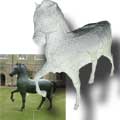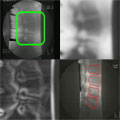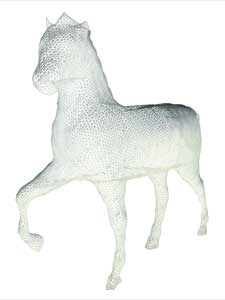Old Projects (before 2005)


Outdoor 3D Scanner Using Off-the-shelf Digital Camera

The generation of realistic 3D models of real world objects is of great interest in many fields and has many practical applications. For instance, such 3D models can be used in reverse engineering, model-based tracking system, video games, virtual reality, movie making and internet showroom. Traditionally, in computer graphics, such 3D models are constructed using specialized design software in a polygon-by-polygon fashion. Such an approach is very time consuming and the quality of the output model depends very much on the skill of the operator. The introduction of laser scan systems allows 3D objects to be "scanned" into the computer directly, and makes the 3D modeling process faster and easier. In spite of that, such systems are very expensive and require careful calibration before use. Besides, they cannot cope with specular surfaces nor surfaces with low reflectance, and can only handle objects of limited size. This project aims at providing a cost-efficient solution to the above problem through the use of computer vision techniques. Vision-based systems do not require direct mechanical measurements on the objects, and can also handle outdoor objects with various size and reflectance. In this project, the following 2 problems will be addressed:

The results of this research project will provide a robust solution to the structure and motion problem, and thus represent significant original contributions to the study of 3D modeling from 2D images. In addition to original research output, this project also provides a complete framework upon which a practical software for 3D model generation from 2D images can be built. With the decrease in price of digital cameras, such a software system would provide a cheap solution for home users, as well as professionals, to create their own digital archive of 3D models.
Tracking of Spinal Motion in Video-fluoroscopy
Low back pain is one of the most common health disorders and its cost is enormous. There is a general consensus that the diagnosis and the treatment of low back pain can be aided by analysing spinal movement. Thus, spinal measurement techniques have been studied widely. At present, videofluoroscopic imaging provides an effective method of obtaining images for spinal motion analysis. Generally, landmarks of a moving vertebra will be extracted from videofluoroscopic video and will then be analysed. Landmarks are usually the corners of the moving vertebra and are usually extracted manually. Unfortunately, the analysis is difficult and time consuming due to the low quality of the videofluoroscopic images. Thus, automatic extraction of landmarks is studied in this project.
In this project, a method in which an active contour (or snake) will attach to the vertebrae automatically throughout the video sequence is proposed. Users only need to define landmark positions on the first videofluoroscopic image. The active contour formed from such landmarks will attach to the vertebra automatically in the remaining video images. This greatly reduces the effort of physicians in setting accurate landmarks of vertebra manually in every video frame. The reduction in human intervention means the reduction in error rate due to fatigue of the operator. Analysis on spinal motion can be done much more effectively and accurately.